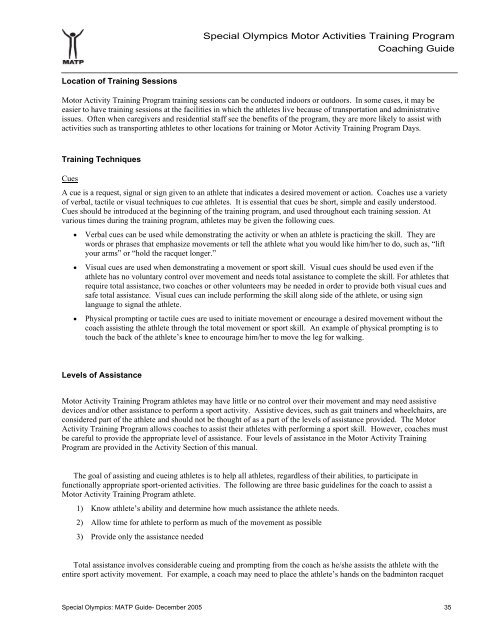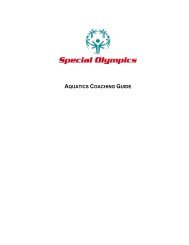MATP Coaching Guide - Special Olympics
MATP Coaching Guide - Special Olympics
MATP Coaching Guide - Special Olympics
Create successful ePaper yourself
Turn your PDF publications into a flip-book with our unique Google optimized e-Paper software.
Location of Training Sessions<br />
<strong>Special</strong> <strong>Olympics</strong> Motor Activities Training Program<br />
<strong>Coaching</strong> <strong>Guide</strong><br />
Motor Activity Training Program training sessions can be conducted indoors or outdoors. In some cases, it may be<br />
easier to have training sessions at the facilities in which the athletes live because of transportation and administrative<br />
issues. Often when caregivers and residential staff see the benefits of the program, they are more likely to assist with<br />
activities such as transporting athletes to other locations for training or Motor Activity Training Program Days.<br />
Training Techniques<br />
Cues<br />
A cue is a request, signal or sign given to an athlete that indicates a desired movement or action. Coaches use a variety<br />
of verbal, tactile or visual techniques to cue athletes. It is essential that cues be short, simple and easily understood.<br />
Cues should be introduced at the beginning of the training program, and used throughout each training session. At<br />
various times during the training program, athletes may be given the following cues.<br />
Verbal cues can be used while demonstrating the activity or when an athlete is practicing the skill. They are<br />
words or phrases that emphasize movements or tell the athlete what you would like him/her to do, such as, lift<br />
your arms or hold the racquet longer.<br />
Visual cues are used when demonstrating a movement or sport skill. Visual cues should be used even if the<br />
athlete has no voluntary control over movement and needs total assistance to complete the skill. For athletes that<br />
require total assistance, two coaches or other volunteers may be needed in order to provide both visual cues and<br />
safe total assistance. Visual cues can include performing the skill along side of the athlete, or using sign<br />
language to signal the athlete.<br />
Physical prompting or tactile cues are used to initiate movement or encourage a desired movement without the<br />
coach assisting the athlete through the total movement or sport skill. An example of physical prompting is to<br />
touch the back of the athlete s knee to encourage him/her to move the leg for walking.<br />
Levels of Assistance<br />
Motor Activity Training Program athletes may have little or no control over their movement and may need assistive<br />
devices and/or other assistance to perform a sport activity. Assistive devices, such as gait trainers and wheelchairs, are<br />
considered part of the athlete and should not be thought of as a part of the levels of assistance provided. The Motor<br />
Activity Training Program allows coaches to assist their athletes with performing a sport skill. However, coaches must<br />
be careful to provide the appropriate level of assistance. Four levels of assistance in the Motor Activity Training<br />
Program are provided in the Activity Section of this manual.<br />
The goal of assisting and cueing athletes is to help all athletes, regardless of their abilities, to participate in<br />
functionally appropriate sport-oriented activities. The following are three basic guidelines for the coach to assist a<br />
Motor Activity Training Program athlete.<br />
1) Know athlete s ability and determine how much assistance the athlete needs.<br />
2) Allow time for athlete to perform as much of the movement as possible<br />
3) Provide only the assistance needed<br />
Total assistance involves considerable cueing and prompting from the coach as he/she assists the athlete with the<br />
entire sport activity movement. For example, a coach may need to place the athlete s hands on the badminton racquet<br />
<strong>Special</strong> <strong>Olympics</strong>: <strong>MATP</strong> <strong>Guide</strong>- December 2005 35
















